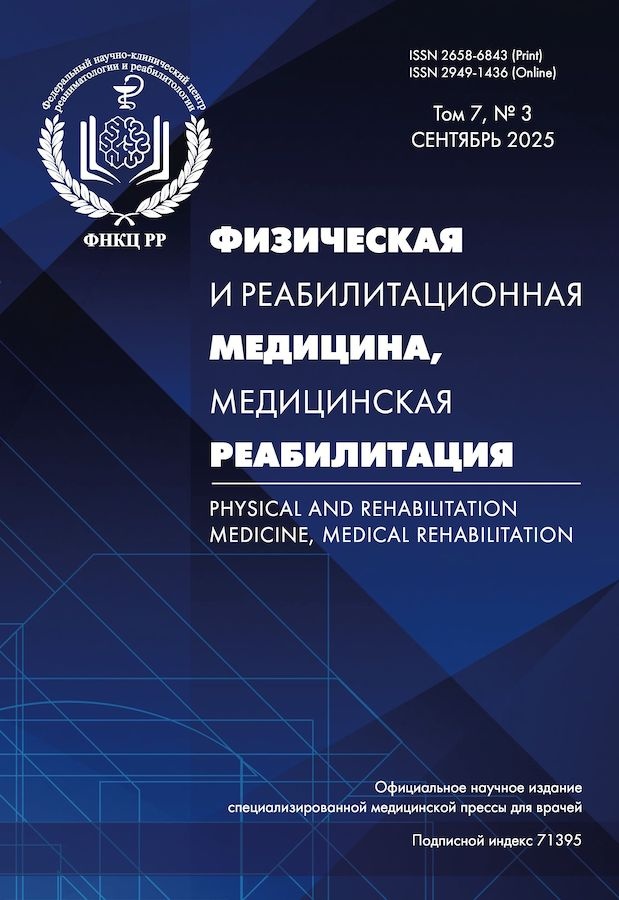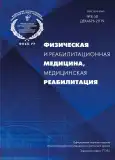Rehabilitation of patients with early scoliosis after stage corrections of spine deformations by growing systems
- Authors: Nikolaev NS1, Petrova RV1, Syundyukov AR1, Kornyakov PV1, Yakovleva SK1, Kuz'mina VA1
-
Affiliations:
- Federal State Budgetary Institution Federal Center of Traumatology, Orthopedics and endoprosthesis replacement of Ministry of Health of the Russian Federation
- Issue: Vol 1, No 4 (2019)
- Pages: 11-19
- Section: Articles
- URL: https://journal-vniispk.ru/2658-6843/article/view/19211
- DOI: https://doi.org/10.36425/2658-6843-2019-4-11-19
- ID: 19211
Cite item
Full Text
Abstract
Full Text
##article.viewOnOriginalSite##About the authors
N S Nikolaev
Federal State Budgetary Institution Federal Center of Traumatology, Orthopedics and endoprosthesis replacement of Ministry of Health of the Russian Federation
R V Petrova
Federal State Budgetary Institution Federal Center of Traumatology, Orthopedics and endoprosthesis replacement of Ministry of Health of the Russian Federation
Email: rpetrova@orthoscheb.com
A R Syundyukov
Federal State Budgetary Institution Federal Center of Traumatology, Orthopedics and endoprosthesis replacement of Ministry of Health of the Russian Federation
Email: sndk-ar@yandex.ru
P V Kornyakov
Federal State Budgetary Institution Federal Center of Traumatology, Orthopedics and endoprosthesis replacement of Ministry of Health of the Russian Federation
S K Yakovleva
Federal State Budgetary Institution Federal Center of Traumatology, Orthopedics and endoprosthesis replacement of Ministry of Health of the Russian Federation
V A Kuz'mina
Federal State Budgetary Institution Federal Center of Traumatology, Orthopedics and endoprosthesis replacement of Ministry of Health of the Russian Federation
References
- Classification of Early-Onset Scoliosis (C-EOS). JBJS 2014;96(16): 1359-1367.
- Виссарионов С.В., Картавенко К.А., Голубев К.Е., Батпенов Н.Д., Абдалиев С.С. Оперативное лечение детей с врожденным нарушением формирования позвонков в поясничном отделе позвоночника // Травматология и ортопедия России. 2012. Т. 1. № 63. С. 89-93.
- Кокушин Д.Н., Виссарионов С.В., Картавенко К.А., Белянчиков С.М. Хирургическая коррекция врожденных деформаций грудопоясничного сегмента позвоночника у детей // Международный журнал прикладных и фундаментальных исследований. 2015. № 8-1. С. 49-51.
- Рябых С.О., Губин А.В., Савин Д.М., Филатов Е.Ю. Результаты резекции полупозвонков грудного и поясничного отделов дорсальным педикулярным доступом у детей // Гений ортопедии. 2015. № 4. С. 42-47.
- Hedequist D, Emans J, Proctor M. Three rod technique facilitates hemivertebra wedge excision in young children through a posterior only approach. Spine. 2009;34:E225-E229. DOI: 10.1097/ BRS.0b013e3181997029.
- Peng X, Chen L, Zou X. Hemivertebra resection and scoliosis correction by a unilateral posterior approach using single rod and pedicle screw instrumentation in children under 5 years of age. J PediatrOr-thop B. 2011;20:397-403. DOI: 10.1097/ BPB.0b013e3283492060.
- Ruf M, Jensen R, Letko L, Harms J. Hemivertebra resection and osteotomies in congenital spine deformity. Spine. 2009;34:1791-1799. DOI: 10.1097/ BRS.0b013e3181ab6290.
- Xu W, Yang S, Wu X, Claus C. Hemivertebra excision with short-seg-ment spinal fusion through combined anterior and posterior approaches for congenital spinal deformities in children. J PediatrOr-thop B. 2010;19:545-550. DOI: 10.1097/ BPB.0b013e32833cb887
- Михайловский М.В., Новиков В.В., Васюра А.С., Удалова И.Г. Наша концепция раннего выявления и лечения идиопатического сколиоза // Advances in current natural sciences. 2015. № 8. С.36-42.
- Г.В. Пятакова, О.В. Оконешникова, А.О. Кожевникова, С.В. Виссарионов. Психологические аспекты лечения и реабилитации пациентов с подростковым идиопатическим сколиозом: анализ исследований // Ортопедия, травматология и восстановительная хирургия детского возраста. Том 7. Выпуск 2. 2019. С. 103-115.
- Яшков А.В., Литвинов С.А., Мирошниченко А.П., Зацепина О.С. Федеральные клинические рекомендации. Послеоперационное ведение больных со спондилолистезом // Москва, 2015. https:// rehabrus.ru/klinicheskie-rekomendaczii.html [дата обращения 02.08.2019]
- Смычёк, В.Б. Основы МКФ / В. Б. Смычёк. - Минск, 2015. - 432 с. : ил. : - ISBN 978-985-519-750-9/
- Цыкунов М.Б. Шкалы оценки нарушений при патологии опорнодвигательной системы с использованием категорий международной классификации функционирования (дискуссия) // Вестник восстановительной медицины. - 2019. - № 2 (90). - С. 2-12.
- Сюндюков А.Р., Петрова Р.В., Орлова А.В. Подходы к реабилитации после коррекции сколиотической деформации позвоночника // Вестник восстановительной медицины. - 2015. - № 3 (67). - С. 48-54.
Supplementary files







